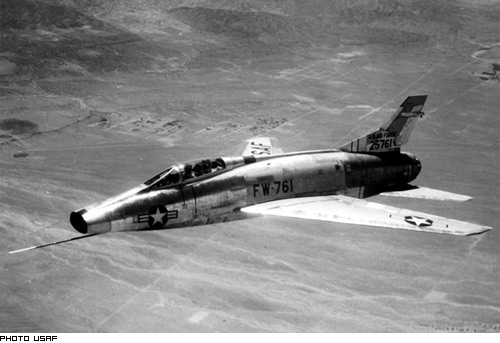North American F-100 Super Sabre
Summary
| Category | Combat aircraft |
| Origin country | 🇺🇸 United States |
| First flight | 25 May 1953 |
| Year of introduction | 1954 |
| Number produced | 2294 units |
| Average unit price | $2 million |
Description
The F-100 Super Sabre was envisioned during the late 1940s as a higher-performance successor to the F-86 Sabre air superiority fighter. Initially referred to as the Sabre 45, it was delivered as an unsolicited proposal to the USAF in January 1951, leading to two prototypes being ordered one year later following modifications. The first YF-100A performed its maiden flight on 25 May 1953, seven months ahead of schedule. Flight testing demonstrated the F-100's promising performance but also several deficiencies, which included a tendency towards yaw instability and inertia coupling that contributed to numerous accidents.
The North American F-100 Super Sabre incorporated design elements such as a stabilator, an all-moving tailplane, one of the first aircraft to feature this, employing a unique gearing and spring system attached to the control stick to mitigate pilot-induced oscillation. Titanium was used extensively throughout key airframe areas. The aircraft also integrated black boxes for the yaw and pitch axes and incorporated modifications to the vertical tail surfaces, including reshaping, shortening of the tailfin, and increased chord of the rudder, to address handling difficulties, particularly yaw instability and inertia coupling. Further modifications included the replacement of the original afterburners of the J-57 engines with more advanced afterburners from retired Convair F-102 Delta Dagger interceptors to resolve maintenance and operational issues, including compressor stall.
On 27 September 1954, the F-100A officially entered USAF service; however, early service was marked by a series of accidents, leading to the type being grounded by 10 November 1954, while investigations and remedial work were conducted. The F-100 returned to flight in February 1955. Later, in response to a Tactical Air Command requirement, the F-100C fighter-bomber was developed, followed by the more capable F-100D.
The F-100D was armed with four 20 mm M39A1 revolver cannons, each with 200 rounds, housed in the lower fuselage. The aircraft featured six hardpoints capable of carrying up to 7,040 lb (3,190 kg) of ordnance, including AIM-9 Sidewinder air-to-air missiles, AGM-12 Bullpup air-to-ground missiles, or LAU-3/A 2.75" (70 mm) unguided rocket dispensers. Additionally, it could carry conventional bombs, or Mark 7, Mk 28, Mk 38, or Mk 43 nuclear bombs. The F-100F trainer variant saw its cannon armament reduced from four to two guns.
The F-100 saw combat use during the Vietnam War, initially as a MiG combat air patrol escort for F-105 Thunderchiefs and later primarily in the close air support role until being replaced by the A-7 Corsair II, F-111 Aardvark, and F-4 Phantom II. During the conflict, 242 F-100s were lost. In the early 1970s, the USAF began permanently withdrawing its F-100s, with the Air National Guard (ANG) continuing to operate the type until 1979. The F-100 was also exported to NATO air forces and other U.S. allies, including the Turkish Air Force, Republic of China Air Force, and French Air Force. Turkish F-100s were deployed during the Turkish invasion of Cyprus, performing close air support missions, while French F-100s saw action during the Algerian War.
Main Variants:
-
YF-100A: The prototype model, designated NA-180, of which two were built for testing the initial design and performance characteristics.
-
F-100A: The initial single-seat day fighter variant, with 203 aircraft built under the NA-192 model designation, entering USAF service in 1954.
-
RF-100A ("Slick Chick"): Six F-100A aircraft modified in 1954 for photo reconnaissance, featuring an unarmed configuration and camera installations in the lower fuselage bay.
-
F-100C: A fighter-bomber variant with additional fuel tanks in the wings, probe-and-drogue refueling capability, and, on later production models, an uprated J57-P-21 engine.
-
F-100D: A single-seat fighter-bomber featuring more advanced avionics, a larger wing and tail fin, and landing flaps, which became the definitive model.
Technical specifications
| Version: F-100D | |
|---|---|
| Crew | 1 pilot |
| Maximum speed | 1390 km/h (864 mph) |
| Wing area | 37 m² (398.3 sqft) |
| Wingspan | 11.8 m (38.7 ft) |
| Height | 5.0 m (16.2 ft) |
| Length | 15.2 m (49.9 ft) |
| Service ceiling | 15240 m (50000 ft) |
| Empty weight | 9500 kg (20944 lbs) |
| Max. takeoff weight | 15800 kg (34833 lbs) |
| Climb rate | 114.0 m/s (374.0 ft/s) |
| Powerplant | 1 × turbojet Pratt & Whitney J57-P-21 delivering 4587 kgp, up to 7238 kgp with afterburner |
| Ejection seat | North American WA-1 |
Current operating countries
No country is operating the F-100 Super Sabre in 2025.
All operators
Denmark • France • Turkey • Taiwan • United States
Armament
Missiles payload:
- Air-to-Surface AGM-12 Bullpup
- Air-to-Air Short-Range Raytheon AIM-9 Sidewinder
Bombs payload:
- Thermonuclear B28 (脡U : Mk 28)
- Thermonuclear B43 Mod 1
- Thermonuclear B57 Mod 1
- Thermonuclear B61
- Nuclear Mark 7
Photo of F-100 Super Sabre

3-view profile
